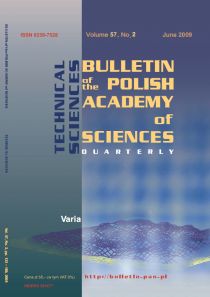POLISH ACADEMY of SCIENCES
TECHNICAL SCIENCES

| BULLETIN
of the
POLISH ACADEMY of SCIENCES TECHNICAL SCIENCES |
 |
|||
|---|---|---|---|---|
| Volume
58, Issue 4, December 2010
|
||||
| Issue Index | Authors Index | Scope Index | Web Info | |
|
|
||||
| Aims&Scope, Subscription | Editors | Authors' guide | to read PDF files | mirror: http://fluid.ippt.gov.pl/~bulletin/ |
| pp 503 - 508 |
|---|
|
Towards tuning of thermal sensitivity of the long period fiber gratings using a liquid crystal layer |
|---|
| A. CZAPLA, W.J. BOCK1, P. MIKULIC, and T.R. WOLINSKI |
| A high-efficiency thermal tuning filter based on a long-period fiber grating (LPFG) combined with a low-birefringence liquid crystal (LB LC) cladding layer is presented. Two types of LPFGs were studied and compared: the LPFGs based on a standard telecommunication fiber produced by an electric arc technique, and the LPFGs based on a boron co-doped fiber written by a UV technique. Both types of LPFGs when enhanced with an external LB LC layer exhibit two different temperature sensitivities, which depend on the temperature range of operation. For the LPFGs based on standard telecommunication fiber we can conclude that the presence of the LB LC cladding increases the thermal tuning efficiency by more than one order of magnitude over the value for the LPFGs in air. In the case of the LPFGs based on the boron co-doped fiber we discovered it is possible to obtain either a temperature-independent attenuation band or the attenuation bands with high temperature sensitivities, just by careful choice of the order of the cladding mode and the operating wavelength. |
| Key words: |
|
long period fiber grating, liquid crystal, sensors |
|
|
| Issue Index | Authors Index | Scope Index | Web Info |
|---|---|---|---|
|
|
|||
| Aims&Scope, Subscription | Editors | Authors' guide | to read PDF files |
| Copyright ® Bulletin of the Polish Academy of Sciences: Technical Sciences |
|---|